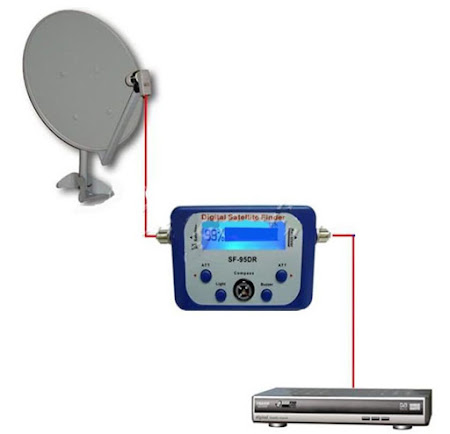Satellite Finder is a handheld device designed to help technicians locate television satellites in order to position satellite dishes. It’s a handy device if you work with satellites often, but most people don’t have any real use for that functionality. 
They are simple to operate and are designed to be used while you're at the satellite dish so you don't have to check your signal strength at your television set. There are both analog and digital models available, both with and without internal power supplies.
The digital satellite finder is microprocessor controlled, making it very reliable and accurate. Signal strength is presented graphically on the LCD display in form of thermometer-scale and in numbers (0-99). It can also present pitch tones (the higher tone the better signal) on a buzzer. The digital sat-finder is very sensitive and can detect the weakest of signals, strong incoming signals (powerful satellite, big dishes) can easily be attenuated for better readout.
Features:
Mini size and light weight, really portable.
Designed with a compass for easier and quicker tuning.
LCD graphic display with LED backlit to show the satellite signal intensity.
Connect to your LNB and receiver to the satellite finder to track the clearest setting for the satellite you wish to tune to.
No external power or Batteries required, power supplied from your satellite receiver.
With buzzer and attenuation control function, easy user-friendly operation.
Specifications:
Material: ABS
Impedance: 75Ω
Gain: ≥10dB
Power Supply: DC13-18V
Signal Detection: 0Hz/22KHz
Frequency Range: 950-2150MHz
Input Level Range: -40~-10dBm
Operating Range: 52-60dB
Operating Temperature: 0-40°C
Item Size: Approx. 12.7 * 6.5 * 2.5cm / 5 * 2.56 * 0.98in
Item Weight: Approx. 92g / 3.26oz
Package Weight: Approx. 169g/ 5.98oz
Package Size: Approx. 18 * 10.5 * 5.5cm / 7.09 * 4.13 * 2.16in

Step 1
Connect one end of the coaxial cable to the barrel connector on the satellite dish's low noise block downconverter (LNB) and the other end to the satellite finder meter. The LNB is the arm that faces the reflector dish.
Step 2
Loosen the nuts that allow the dish to be adjusted both along the horizontal (azimuth) and vertical (elevation) planes.

Step 3
Move the dish from side to side along the horizontal plane until you determine the position at which the satellite finder meter displays maximum signal strength.
If you're using an analog meter, you will find this position in increments. First, adjust the gain knob so the meter's needle reads half strength. As you move the dish closer to its optimal position, the meter may exceed maximum. If this happens, readjust the gain lower and continue to move the dish until you determine the position where maximum signal strength is received.
Step 4
Raise and lower the dish along the vertical plane until you determine the elevation at which the satellite finder meter displays maximum signal strength. If using an analog meter, you may have to adjust the gain as in the previous step.Step 5
Tighten the nuts to lock your satellite dish into place.
Step 6
Disconnect the coaxial cable from the LNB on the satellite dish.









Comments
Post a Comment